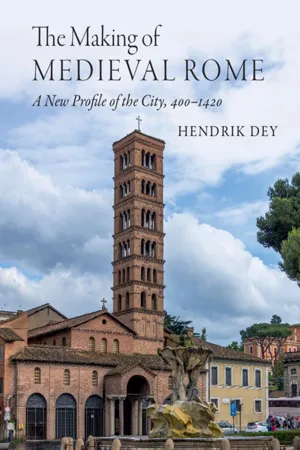
- English
- PDF
- Available on iOS & Android
About this book
Integrating the written sources with Rome's surviving remains and, most importantly, with the results of the past half-century's worth of medieval archaeology in the city, The Making of Medieval Rome is the first in-depth profile of Rome's transformation over a millennium to appear in any language in over forty years. Though the main focus rests on Rome's urban trajectory in topographical, architectural, and archaeological terms, Hendrik folds aspects of ecclesiastical, political, social, military, economic, and intellectual history into the narrative in order to illustrate how and why the cityscape evolved as it did during the thousand years between the end of the Roman Empire and the start of the Renaissance. A wide-ranging synthesis of decades' worth of specialized research and remarkable archaeological discoveries, this book is essential reading for anyone interested in how and why the ancient imperial capital transformed into the spiritual heart of Western Christendom.
Frequently asked questions
- Essential is ideal for learners and professionals who enjoy exploring a wide range of subjects. Access the Essential Library with 800,000+ trusted titles and best-sellers across business, personal growth, and the humanities. Includes unlimited reading time and Standard Read Aloud voice.
- Complete: Perfect for advanced learners and researchers needing full, unrestricted access. Unlock 1.4M+ books across hundreds of subjects, including academic and specialized titles. The Complete Plan also includes advanced features like Premium Read Aloud and Research Assistant.
Please note we cannot support devices running on iOS 13 and Android 7 or earlier. Learn more about using the app.
Information
Table of contents
- Cover
- Half-title page
- Title page
- Copyright page
- Contents
- Preface
- Introduction
- Chapter 1 The Eternal City on the Brink: Rome in AD 400
- Chapter 2 401–552: From Imperial Metropolis to Provincial Town
- Chapter 3 552–705: Byzantine Rome
- Chapter 4 705–882: A Papal “Republic of the Romans”
- Chapter 5 The Long Twilight of the Early Middle Ages: 882–1046
- Chapter 6 1046–1230: Church Reformed, Senate Reborn, Rome Renascent
- Chapter 7 1230–1420: Barons, Babylonian Captivity, and Black Death: The Apogee and Agony of Late Medieval Rome
- Epilogue: Rome and Pope Nicholas V(1447–55)
- References
- Index